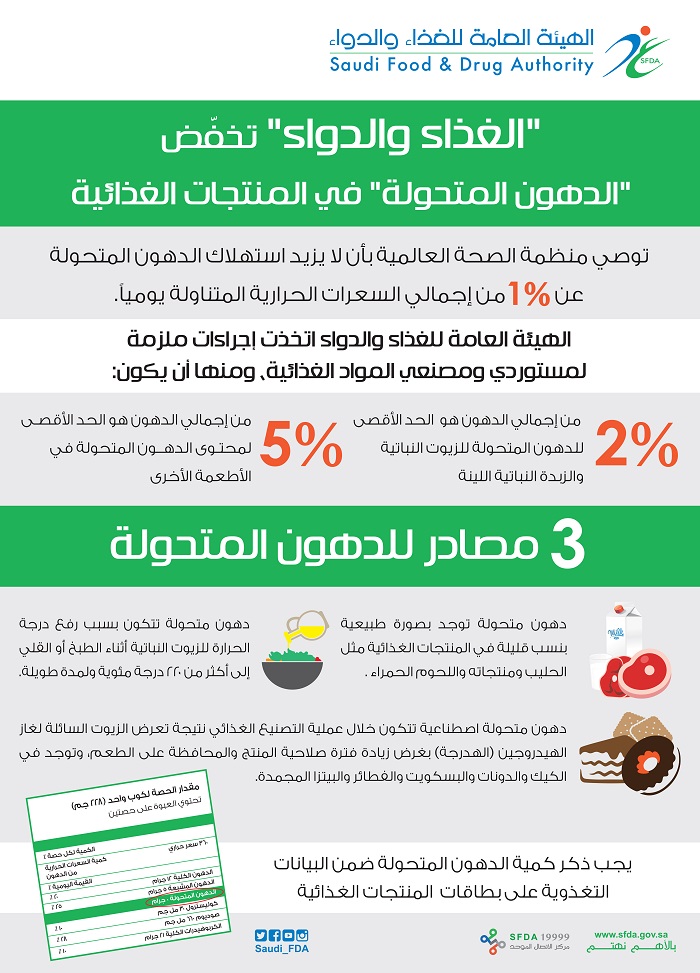SFDA applied strict measures to reduce consumption of Trans Fats (Amino Acids) in Food Products.
SFDA advised the respective importers and manufacturers of the importance of complete adherence to the requirements of GSO 2483”Trans Fats” (Amino Acids) and forced them to write the trans fats in the nutritional facts, on food products labeling according to the requirements of Saudi Standard Specifications/Gulf Specifications GSO 2233 “requirements of nutritional facts on food products labeling” and GSO 2483 “Trans Fats”
According to GSO 2483 “Trans Fats” (Amino Acids), the manufacturers of food products that contain “Trans Fats” shall reconsider the constituents of these products (used fats or oils) and find alternatives for “Trans Fats” sources and to comply with the requirements of this regulation. E.g., the maximum limit of “Trans Fats” of vegetables oils and margarine shall be 2% and the maximum limit of “Trans Fats” in other foods shall be 5% of the total content of fats.
SFDA stressed that the nutritional facts table shall to include the amount of Trans fatty acids in food, including nutritional supplements, and shall reflect the content in grams and percentage of the daily value, which should appear in a column on the right side of the label.
This action comes within the framework of SFDA follow-up of the international developments, especially regarding the safety of food products and their impact on consumer health and in line with WHO recommendations (WHO) in this regard, and in order to avoid the impact of food products containing high amounts of trans fats, on health.
SFDA gave a grace period to the importers and manufacturers of food products, before taking legal action in the event of their non-compliance.
Fats are found in vegetables and animal food and are considered the main source of energy in the body and help in absorption of vitamins, such as vitamins (A, D, E, K), which are also important for proper growth and maintaining good health.
Fats are divided into two main categories; the first category includes saturated fats which consist of a series of fatty acids linked together by a single bond and abundant in high concentrations in animal products.
The second category includes unsaturated fats which consist of a series of fatty acids that are linked together by bonds containing one double bond, at least, and are is present at high concentrations in vegetable oils.
Scientific studies proved of a correlation between the increase in taking Trans fats and the increased risk of cardiovascular diseases. The danger of Tran’s fats is that they increase the level of bad cholesterol (LDL), where its high level in the blood increases the risk of these diseases which is considered one of the main causes of death.
The World Health Organization recommended that consumption of fats got adults shall not exceed 30% of the total calories per day and that the consumption of Trans fats shall not exceed 1% of the total calories.
Three sources of Tran Fats: The first source is the Trans fats that are naturally exist in food products such as milk and milk products and red meat. The quantity of Trans Fats in these products ranges between 3 and 6% of the total fats.
The second source of fat is the processed Trans Fats, which os formed during food manufacturing process as a result of exposure of liquid oils to hydrogen gas to transform to solid fats, in order to increase the validity period of the product and to maintain its taste. This process is called hydrogenation. These fats are found in many food products such as cakes and donuts, biscuits, pancakes, frozen pizza. Partially hydrogenated oils are considered the main source of Trans fats in food.
The third source of trans fat is the vegetable oils that are exposed to high temperature during cooking or frying up to over 220 ° C, for a long time.
Where are Trans Fats found?
Tans fats are found in many foods such as margarine or solid vegetable butter, salted biscuits, sweet cakes, pies and frozen pizza and other baked foods, wherein margarine or solid vegetable butter is added. They are also found in fast foods that may use boiled vegetable oils at high temperatures for a long time. In addition to snacks such as " microwave pop corn," wherein partially hydrogenated oils and some types of coffee mate are added, which include partially hydrogenated, milk, dairy products and red meat in their components wherein trans fats exist naturally at low percentages.


